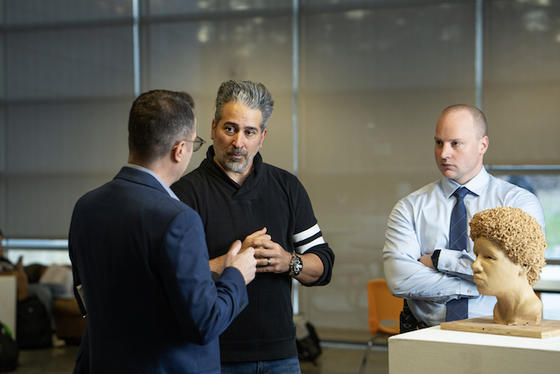George Mason University’s Joe Mullins thinks he has the coolest job in the world, and calls what he does ‘art with a purpose.’
The field of forensic art is no longer limited to sketches—it has evolved into a powerful tool that helps bring closure to unsolved cases and missing persons investigations. Combining cutting-edge technology with artistic skill, forensic artists can reconstruct faces and features from skeletal remains, often providing vital clues law enforcement needs to solve cold cases.

Mullins, a forensic artist and adjunct professor, exemplifies this new era of forensic art. Most recently, detectives from nearby Loudoun County, Virginia, turned to him to help on one of their oldest cold cases. He collaborated with students in his AVT 496 Forensic Figure Sculpture class, in the School of Art within George Mason’s College of Visual and Performing Arts, to create a lifelike, three-dimensional clay reconstruction of a woman known only as “Jane Doe,” whose remains were discovered on May 28, 1973. Advancements in forensic science and technology reopened the case after decades without a lead.
Using a 3D scan of the victim’s skull and DNA data, revealing traits such as eye color, hair type, and body composition, Mullins and his students sculpted a bust that depicts the features of an African American woman believed to have been in her 20s or 30s. She had been shot, carried no identification, and local law enforcement had no reports of anyone missing who fit that description at the time. Loudoun County detectives hope that this lifelike construction will lead to someone finally recognizing her.
“Forensic artists are often the last hope for these cases,” he said. “So, with that comes a lot of responsibility to get it right. The only way these reconstructions work is if the right person sees it. With nearly 8 billion people on the planet, we just need one, and one person to say, ‘I think I know who that is.’”
That happened in 2015, when a clay bust he created helped identify a John Doe in New York City when a family member recognized the face. He hopes for a similar outcome with Jane Doe.
Mullins, who also serves as a senior forensic imaging specialist at the National Center for Missing and Exploited Children (NCMEC), incorporates real cases into his teaching.
“Watching a face come to life gives students a deeper connection to their work,” he said. “They became just as emotionally invested in this case as I did.”
George Mason’s Forensic Science Program within the College of Science played a critical role in reopening the investigation. Assistant professor Steven Burmeister used on ground-penetrating radar to guide Loudoun County investigators to locate Jane Doe’s remains in 2023, which were exhumed from an unmarked grave in Lincoln, Virginia. The remains were analyzed by the Office of the Chief Medical Examiner, where a DNA profile was created.
For students like senior communication major Marie Elizabeth Seagraves, the class was transformative.
“I originally took this class because it seemed fun and super-interesting, as I’ve never done sculpture work before,” Seagraves said. “But learning how this work can help so many people find closure made it so much more meaningful.”
The work has already garnered significant media attention, and the Loudoun County Sheriff’s Office hopes the renewed interest will lead to a breakthrough of this case and at long last bring some measure of peace to Jane Doe’s family.
According to Mullins, there are more than 2,000 unidentified sets of remains in offices of local medical examiners across the country. Having grown up in Loudoun County, he was moved by the opportunity to contribute to a case so close to home.
“I’ve never been able to fully articulate the feeling when one of these reconstructions is successful,” he said. “Helping these families get the answers they have been searching for is all the satisfaction I need.”
Related News
- November 17, 2025
- November 3, 2025
- October 30, 2025
- October 16, 2025
- October 6, 2025
